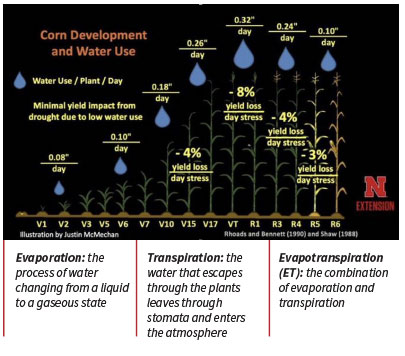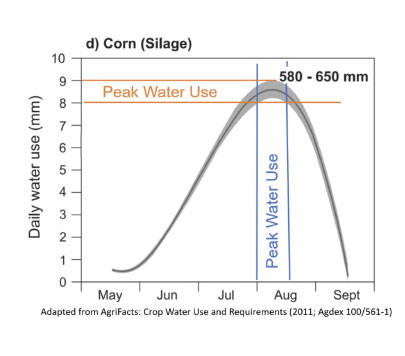Corn Water Use - Western Canada
During the mid to late vegetative stages of crop development, that nearly all water uptake is done by the nodal root system. The initial root system the corn developed as a seedling, is no longer providing the plant with substantial water or nutrients and from approximately V3 and onward the nodal root system is doing the majority of nutrient and water uptake.
Water Utilization by the Numbers:
- 120 bu/ac yield requires ~21 inches of water (Field Corn Production in MB)
- Approx. 350 L of water is taken up and evaporated per kg of dry matter produced (Field Corn Production in MB)
- Evapotranspiration (ET) values vary greatly from day to day (0.04 to 0.40 inches/day) - soil type, climate and growth stage will influence ET rates (Iowa State: Corn Water Use and Evapotranspiration)

Crop water use is the amount of water used by the plant to grow and cool. When we think about corn water use, we need to consider 2 points:
- Is there enough water available so that crop stress is not visible?
- Is the soil water storage relatively ‘full’ before peak water use occurs?
Peak water use tends to occur in the last week of July and the first two weeks of August in Western Canada and lasts for two weeks.

Water shortage at any point in the growing season can negatively impact yield potential. But keep in mind that early and late in the growing season less water is required compared to the middle of the growing season.
Most of the prairies saw mid to high 30’s the last week of June. These intense temperatures occurred during the mid vegetative stage (V6-V8) which could affect the number of kernels rows per ear and stem/leaf cell expansion resulting in shorter plants with smaller leaves. By mid morning during these intense temperatures many corn fields looked more like pineapple tops. Corn plants rolled up their leaves to prevent further moisture loss. This is a defence mechanism the corn plant has developed to handle hot temperatures and low humidity conditions. Leaf rolling does not always result in yield loss. When the leaves stay rolled for longer than 12 hours a day yield tends to suffer. The earlier in the day and the longer the leaves stay rolled up, the greater yield can be impacted.
Water use will continue to increase through vegetative growth and should peak in 2-3 weeks for fields planted in the first two weeks of May. Peak water use occurs during the silking and pollination stage (VT/R1). During these stages water use can be as high as 0.40”/day. Insufficient water supply during this period can result in poor pollination due to pollen grains and silks drying up, ultimately reducing the number of kernels per ear.
Peak water use for corn silage in Alberta tends to fall in the first 2 weeks of August. During this time the crop is using 8-9mm/ day depending on the hybrid, plant stand and/or environmental conditions (indicated by grey area on graph top right).

